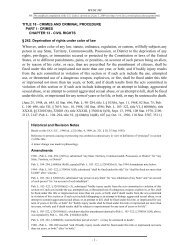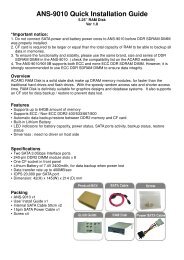2004 Instructions for Form 1040 (ALL) - Supreme Law Firm
2004 Instructions for Form 1040 (ALL) - Supreme Law Firm
2004 Instructions for Form 1040 (ALL) - Supreme Law Firm
You also want an ePaper? Increase the reach of your titles
YUMPU automatically turns print PDFs into web optimized ePapers that Google loves.
8582), enter in the applicable column of If you are treating REMIC items on<br />
Line 27<br />
line 28 your current year ordinary income your tax return differently from the way the<br />
If you answered “Yes” on line 27, follow or loss from the partnership or S corporamay<br />
have to file <strong>Form</strong> 8082.<br />
REMIC reported them on its return, you<br />
the instructions below. If you fail to follow tion. Report each related item in the applithese<br />
instructions, the IRS may send you a cable column of a separate line following If you are the holder of a residual internotice<br />
of additional tax due because the the line on which you reported the current est in more than one REMIC, attach a continuation<br />
sheet using the same <strong>for</strong>mat as in<br />
amounts reported by the partnership or S year ordinary income or loss. Also enter a<br />
corporation on Schedule K-1 do not match description of the related item (<strong>for</strong> exam- Part IV. Enter the totals of columns (d) and<br />
the amounts you reported on your tax re- ple, depletion) in column (a) of the same (e) on line 39 of Schedule E. If you also<br />
turn.<br />
line.<br />
completed Part I on more than one Sched-<br />
ule E, use the same Schedule E on which<br />
Losses Not Allowed in Prior If you are required to file <strong>Form</strong> 8582, you entered the combined totals in Part I.<br />
Years Due to the At-Risk or Basis see the <strong>Instructions</strong> <strong>for</strong> <strong>Form</strong> 8582 be<strong>for</strong>e<br />
completing Schedule E.<br />
REMIC income or loss is not income or<br />
Limitations<br />
loss from a passive activity.<br />
• Enter your total prior year unallowed<br />
losses that are now deductible on a separate<br />
Note. If you are the holder of a regular<br />
line in column (h) of line 28. Do not comto<br />
report the income you received. Instead,<br />
interest in a REMIC, do not use Schedule E<br />
bine these losses with, or net them against, Part III<br />
any current year amounts from the partner-<br />
report it on <strong>Form</strong> <strong>1040</strong>, line 8a.<br />
Income or Loss From<br />
ship or S corporation.<br />
Estates and Trusts<br />
Column (c). Report the total of the<br />
• Enter “PYA” (prior year amount) in amounts shown on Schedule(s) Q, line 2c.<br />
column (a) of the same line.<br />
If you are a beneficiary of an estate or trust, This is the smallest amount you are allowed<br />
use Part III to report your part of the in- to report as your taxable income (<strong>Form</strong><br />
Prior Year Unallowed Losses come (even if not received) or loss. You <strong>1040</strong>, line 42). It is also the smallest<br />
From a Passive Activity Not<br />
should receive a Schedule K-1 (<strong>Form</strong> 1041) amount you are allowed to report as your<br />
Reported on <strong>Form</strong> 8582<br />
from the fiduciary. Your copy of Schedule alternative minimum taxable income<br />
K-1 and its instructions will tell you where<br />
• Enter on a separate line in column (f)<br />
(AMTI) (<strong>Form</strong> 6251, line 28).<br />
on your return to report the items from<br />
of line 28 your total prior year unallowed Schedule K-1. Do not attach Schedule K-1 If the amount in column (c) is larger<br />
losses not reported on <strong>Form</strong> 8582. Such to your return. Keep it <strong>for</strong> your records. than your taxable income would otherwise<br />
losses include prior year unallowed losses be, enter the amount from column (c) on<br />
If you are treating items on your tax<br />
that are now deductible because you did not <strong>Form</strong> <strong>1040</strong>, line 42. Similarly, if the<br />
return differently from the way the estate or<br />
have an overall loss from all passive activi- amount in column (c) is larger than your<br />
trust reported them on its return, you may<br />
ties or you disposed of your entire interest AMTI would otherwise be, enter the<br />
have to file <strong>Form</strong> 8082.<br />
in a passive activity in a fully taxable transamount<br />
from column (c) on <strong>Form</strong> 6251,<br />
action. Do not combine these losses with,<br />
If you have estimated taxes credited to line 28. Write “Sch. Q” on the dotted line to<br />
you from a trust (Schedule K-1, line 14a), the left of this amount on <strong>Form</strong> <strong>1040</strong> or<br />
or net them against, any current year write “ES payment claimed” and the 6251.<br />
amounts from the partnership or S corpora- amount on the dotted line next to line 37.<br />
tion.<br />
Do not include this amount in the total on Note. These rules also apply to estates and<br />
• Enter “PYA” (prior year amount) in line 37. Instead, enter the amount on <strong>Form</strong> trusts that hold a residual interest in a<br />
column (a) of the same line.<br />
<strong>1040</strong>, line 64.<br />
REMIC. Be sure to make the appropriate<br />
A U.S. person who transferred property<br />
entries on the comparable lines on <strong>Form</strong><br />
Unreimbursed Partnership<br />
to a <strong>for</strong>eign trust may have to report the<br />
1041.<br />
Expenses income received by the trust as a result of Do not include the amount<br />
• You can deduct unreimbursed ordi- the transferred property if, during <strong>2004</strong>, the<br />
shown in column (c) in the total<br />
nary and necessary partnership expenses trust had a U.S. beneficiary. See section<br />
on line 39 of Schedule E.<br />
you paid on behalf of the partnership on 679. An individual who received a distribu-<br />
Schedule E if you were required to pay tion from, or who was the grantor of or<br />
these expenses under the partnership agreeplete<br />
Part III of Schedule B (<strong>Form</strong> <strong>1040</strong>) amounts shown on Schedule(s) Q, line 3b.<br />
transferor to, a <strong>for</strong>eign trust must also com- Column (e). Report the total of the<br />
ment (except amounts deductible only as<br />
itemized deductions, which you must enter<br />
and may have to file <strong>Form</strong> 3520. In addi- If you itemize your deductions on Schedule<br />
tion, the owner of a <strong>for</strong>eign trust must enon<br />
Schedule A).<br />
A, include this amount on line 22.<br />
sure that the trust files an annual<br />
• Enter unreimbursed partnership ex- in<strong>for</strong>mation return on <strong>Form</strong> 3520-A.<br />
penses from nonpassive activities on a separate<br />
line in column (h) of line 28. Do not<br />
combine these expenses with, or net them<br />
Part V<br />
against, any other amounts from the part- Part IV Summary<br />
nership.<br />
• If the expenses are from a passive ac- Income or Loss From Real<br />
tivity and you are not required to file <strong>Form</strong> Estate Mortgage Investment<br />
Line 42<br />
8582, enter the expenses related to a pas- Conduits (REMICs)<br />
derpayment of estimated tax if:<br />
sive activity on a separate line in column (f)<br />
of line 28. Do not combine these expenses<br />
with, or net them against, any other<br />
amounts from the partnership.<br />
• Enter “UPE” (unreimbursed partnership<br />
expenses) in column (a) of the same<br />
line.<br />
Line 28<br />
For nonpassive income or loss (and passive<br />
losses <strong>for</strong> which you are not filing <strong>Form</strong><br />
If you are the holder of a residual interest in<br />
a REMIC, use Part IV to report your total<br />
share of the REMIC’s taxable income or<br />
loss <strong>for</strong> each quarter included in your tax<br />
year. You should receive Schedule Q<br />
(<strong>Form</strong> 1066) and instructions from the<br />
REMIC <strong>for</strong> each quarter. Do not attach<br />
Schedules Q to your return. Keep them <strong>for</strong><br />
your records.<br />
You will not be charged a penalty <strong>for</strong> un-<br />
1. Your gross farming or fishing income<br />
<strong>for</strong> 2003 or <strong>2004</strong> is at least two-thirds of<br />
your gross income, and<br />
2. You file your <strong>2004</strong> tax return and pay<br />
the tax due by March 1, 2005.<br />
E-6













